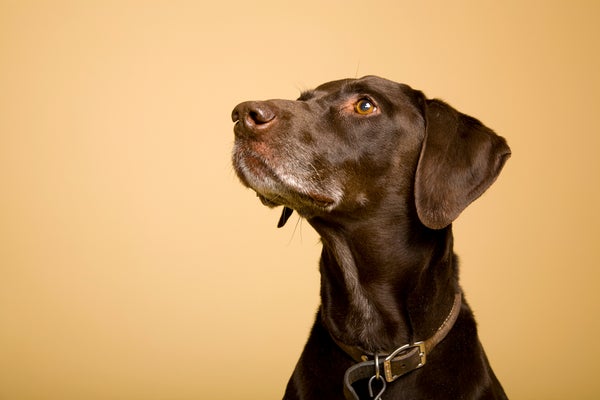Although most of us don’t know it, humans emit hundreds of odor compounds that waft into the air around us. As our bodies change with age, disease and reproductive status, this cloud of volatile chemicals changes, too. What we sweat, secrete and exhale documents the ever-changing landscape inside of us.
As far back as 400 B.C., Hippocrates took note of how some of these odors, especially in urine, reflected disease. But the human olfactory sense—even that of Hippocrates—has nothing on the capacity of the canine nose for detecting smells. And of course, once humans figured that out, we sought to co-opt it for our own uses.
Some dogs have undergone training to detect significant blood sugar changes in people with diabetes or even identify melanoma or prostate cancer with a quick whiff of skin or urine. And then there are the SADs, or seizure-alerting dogs. Their anecdotal ability to detect an oncoming seizure in a beloved human and alert their owners set off a flurry of investigations into the secrets behind their skill. Among the candidates: seizure-specific scent detection.
On supporting science journalism
If you're enjoying this article, consider supporting our award-winning journalism by subscribing. By purchasing a subscription you are helping to ensure the future of impactful stories about the discoveries and ideas shaping our world today.
Now a quintet of canines—Casey, Dodger, Lana, Zooey and Roo—have answered the question of whether or not seizures have odors. It turns out that they do, and these five dogs can detect that smell in a sample swabbed from a human having an episode. Some of the trained detector dogs are better than others—we’re looking at you, Lana and Roo—but they all did well, according to findings published March 28 in Scientific Reports. “The obtained accuracy is very high,” says Tim Edwards, behavioral analyst and senior lecturer at the University of Waikato in Hamilton, New Zealand, who was not involved in the study. “As far as implications go, the results are very exciting.”
Craig Angle, co-director of the Canine Performance Sciences Program in the College of Veterinary Medicine at Auburn University, isn’t surprised by the dogs’ ability to suss out seizure from non-seizure samples. “The dog is a natural bio sensor, preprogramed with 30,000 years of evolutionary algorithms, and 300 million sensory receptors,” says Angle, who also was not involved in the study. A dog brain can detect “massive amounts” of chemical information at thresholds that are much lower than any machines.
To establish whether or not seizures have a smell, Amélie Catala, a doctoral student at Ethos, a center studying animal and human ethology at the Universtity of Rennes, and her colleagues trained Casey, Dodger, Lana, Zooey and Roo as SADs. Learning to be a SAD is a three-step process, starting with positive detection of a seizure scent in association with something pleasant, like a treat or praise. The dogs then learn to discriminate a lab sample of a scent from other potentially confounding odors added in. Their final challenge was to detect a seizure scent placed on a person—one signal out of those hundreds of chemical odors wafting from the human body.
The five SADs then evaluated a series of samples from people they’d never met—or smelled—some taken during a seizure, some after physical exercise, and some just during random moments of the day. After participants wiped their foreheads, hands and necks with cotton pads, they dropped the pad in a ziplock bag, exhaled into the bag and sealed it. These samples were placed in steel cans in groups of seven, and the SAD team went about the work of detecting which ones were taken during a seizure.
Casey, Dodger and Zooey were superstars, getting it right 100 percent of the time and in under five minutes. The other dogs were correct at least 67 percent of the time, and the entire SAD team performed well even with multiple trials. Catala says that the slightly reduced accuracy of Lana and Roo might trace to their having joined the team later and having a little less training.
Because the seizure samples were from patients having different kinds of seizures, the findings suggest that the odor the dogs detected is something common among all seizure episodes, says Edwards. Catala’s team noted that being able to generalize across different types of epilepsy was an unexpected but welcome finding.
How does a seizure go from the brain to an odor the body emits? Angle says that the body produces signature odor chemicals that pass into the bloodstream and then into our breath, sweat and urine. The seizure scent that the SADs detected might reflect a change in cell processes during a seizure that in turn alters the odors the person emits, he says.
The next step for Catala and her team is to use human skills to figure out what exactly is in those emissions. Chemical analyses can separate the various compounds to pinpoint what might differ between seizure- and non–seizure-related samples. Whether or not technology can match a dog remains in question. Dogs can smell in the parts per trillion range, says Angle, which might far exceed what even the most sophisticated machines can detect. Edwards agrees. “It’s likely that dogs are still more sensitive than our most sensitive analytical devices,” he says.
Nevertheless, if dogs can detect seizure odors, Edwards is hopeful that eventually, humans can sub in artificial intelligence (AI) to do the job. Angle and other researchers at Auburn have been imaging the canine olfactory system with the same goal in mind. “If you want to build an AI-based chemical detection system, why not study the most sensitive and advanced real-time chemical detection system on the planet, the dog,” says Angle.
